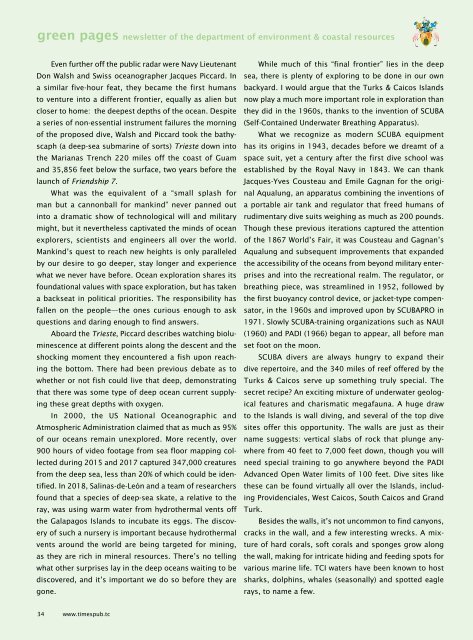Times of the Islands Winter 2020/21
Presents the "soul of the Turks & Caicos Islands" with in-depth features about local people, culture, history, environment, real estate, businesses, resorts, restaurants and activities.
Presents the "soul of the Turks & Caicos Islands" with in-depth features about local people, culture, history, environment, real estate, businesses, resorts, restaurants and activities.
Create successful ePaper yourself
Turn your PDF publications into a flip-book with our unique Google optimized e-Paper software.
green pages newsletter <strong>of</strong> <strong>the</strong> department <strong>of</strong> environment & coastal resources<br />
Even fur<strong>the</strong>r <strong>of</strong>f <strong>the</strong> public radar were Navy Lieutenant<br />
Don Walsh and Swiss oceanographer Jacques Piccard. In<br />
a similar five-hour feat, <strong>the</strong>y became <strong>the</strong> first humans<br />
to venture into a different frontier, equally as alien but<br />
closer to home: <strong>the</strong> deepest depths <strong>of</strong> <strong>the</strong> ocean. Despite<br />
a series <strong>of</strong> non-essential instrument failures <strong>the</strong> morning<br />
<strong>of</strong> <strong>the</strong> proposed dive, Walsh and Piccard took <strong>the</strong> bathyscaph<br />
(a deep-sea submarine <strong>of</strong> sorts) Trieste down into<br />
<strong>the</strong> Marianas Trench 220 miles <strong>of</strong>f <strong>the</strong> coast <strong>of</strong> Guam<br />
and 35,856 feet below <strong>the</strong> surface, two years before <strong>the</strong><br />
launch <strong>of</strong> Friendship 7.<br />
What was <strong>the</strong> equivalent <strong>of</strong> a “small splash for<br />
man but a cannonball for mankind” never panned out<br />
into a dramatic show <strong>of</strong> technological will and military<br />
might, but it never<strong>the</strong>less captivated <strong>the</strong> minds <strong>of</strong> ocean<br />
explorers, scientists and engineers all over <strong>the</strong> world.<br />
Mankind’s quest to reach new heights is only paralleled<br />
by our desire to go deeper, stay longer and experience<br />
what we never have before. Ocean exploration shares its<br />
foundational values with space exploration, but has taken<br />
a backseat in political priorities. The responsibility has<br />
fallen on <strong>the</strong> people—<strong>the</strong> ones curious enough to ask<br />
questions and daring enough to find answers.<br />
Aboard <strong>the</strong> Trieste, Piccard describes watching bioluminescence<br />
at different points along <strong>the</strong> descent and <strong>the</strong><br />
shocking moment <strong>the</strong>y encountered a fish upon reaching<br />
<strong>the</strong> bottom. There had been previous debate as to<br />
whe<strong>the</strong>r or not fish could live that deep, demonstrating<br />
that <strong>the</strong>re was some type <strong>of</strong> deep ocean current supplying<br />
<strong>the</strong>se great depths with oxygen.<br />
In 2000, <strong>the</strong> US National Oceanographic and<br />
Atmospheric Administration claimed that as much as 95%<br />
<strong>of</strong> our oceans remain unexplored. More recently, over<br />
900 hours <strong>of</strong> video footage from sea floor mapping collected<br />
during 2015 and 2017 captured 347,000 creatures<br />
from <strong>the</strong> deep sea, less than 20% <strong>of</strong> which could be identified.<br />
In 2018, Salinas-de-León and a team <strong>of</strong> researchers<br />
found that a species <strong>of</strong> deep-sea skate, a relative to <strong>the</strong><br />
ray, was using warm water from hydro<strong>the</strong>rmal vents <strong>of</strong>f<br />
<strong>the</strong> Galapagos <strong>Islands</strong> to incubate its eggs. The discovery<br />
<strong>of</strong> such a nursery is important because hydro<strong>the</strong>rmal<br />
vents around <strong>the</strong> world are being targeted for mining,<br />
as <strong>the</strong>y are rich in mineral resources. There’s no telling<br />
what o<strong>the</strong>r surprises lay in <strong>the</strong> deep oceans waiting to be<br />
discovered, and it’s important we do so before <strong>the</strong>y are<br />
gone.<br />
While much <strong>of</strong> this “final frontier” lies in <strong>the</strong> deep<br />
sea, <strong>the</strong>re is plenty <strong>of</strong> exploring to be done in our own<br />
backyard. I would argue that <strong>the</strong> Turks & Caicos <strong>Islands</strong><br />
now play a much more important role in exploration than<br />
<strong>the</strong>y did in <strong>the</strong> 1960s, thanks to <strong>the</strong> invention <strong>of</strong> SCUBA<br />
(Self-Contained Underwater Breathing Apparatus).<br />
What we recognize as modern SCUBA equipment<br />
has its origins in 1943, decades before we dreamt <strong>of</strong> a<br />
space suit, yet a century after <strong>the</strong> first dive school was<br />
established by <strong>the</strong> Royal Navy in 1843. We can thank<br />
Jacques-Yves Cousteau and Emile Gagnan for <strong>the</strong> original<br />
Aqualung, an apparatus combining <strong>the</strong> inventions <strong>of</strong><br />
a portable air tank and regulator that freed humans <strong>of</strong><br />
rudimentary dive suits weighing as much as 200 pounds.<br />
Though <strong>the</strong>se previous iterations captured <strong>the</strong> attention<br />
<strong>of</strong> <strong>the</strong> 1867 World’s Fair, it was Cousteau and Gagnan’s<br />
Aqualung and subsequent improvements that expanded<br />
<strong>the</strong> accessibility <strong>of</strong> <strong>the</strong> oceans from beyond military enterprises<br />
and into <strong>the</strong> recreational realm. The regulator, or<br />
breathing piece, was streamlined in 1952, followed by<br />
<strong>the</strong> first buoyancy control device, or jacket-type compensator,<br />
in <strong>the</strong> 1960s and improved upon by SCUBAPRO in<br />
1971. Slowly SCUBA-training organizations such as NAUI<br />
(1960) and PADI (1966) began to appear, all before man<br />
set foot on <strong>the</strong> moon.<br />
SCUBA divers are always hungry to expand <strong>the</strong>ir<br />
dive repertoire, and <strong>the</strong> 340 miles <strong>of</strong> reef <strong>of</strong>fered by <strong>the</strong><br />
Turks & Caicos serve up something truly special. The<br />
secret recipe? An exciting mixture <strong>of</strong> underwater geological<br />
features and charismatic megafauna. A huge draw<br />
to <strong>the</strong> <strong>Islands</strong> is wall diving, and several <strong>of</strong> <strong>the</strong> top dive<br />
sites <strong>of</strong>fer this opportunity. The walls are just as <strong>the</strong>ir<br />
name suggests: vertical slabs <strong>of</strong> rock that plunge anywhere<br />
from 40 feet to 7,000 feet down, though you will<br />
need special training to go anywhere beyond <strong>the</strong> PADI<br />
Advanced Open Water limits <strong>of</strong> 100 feet. Dive sites like<br />
<strong>the</strong>se can be found virtually all over <strong>the</strong> <strong>Islands</strong>, including<br />
Providenciales, West Caicos, South Caicos and Grand<br />
Turk.<br />
Besides <strong>the</strong> walls, it’s not uncommon to find canyons,<br />
cracks in <strong>the</strong> wall, and a few interesting wrecks. A mixture<br />
<strong>of</strong> hard corals, s<strong>of</strong>t corals and sponges grow along<br />
<strong>the</strong> wall, making for intricate hiding and feeding spots for<br />
various marine life. TCI waters have been known to host<br />
sharks, dolphins, whales (seasonally) and spotted eagle<br />
rays, to name a few.<br />
34 www.timespub.tc

















